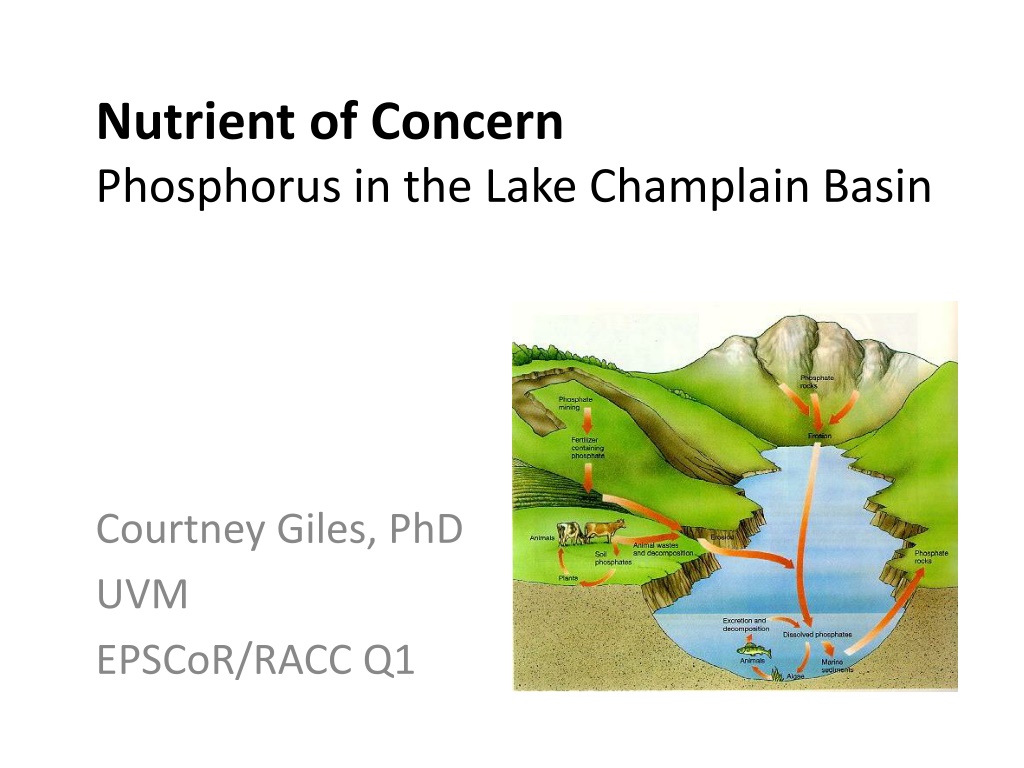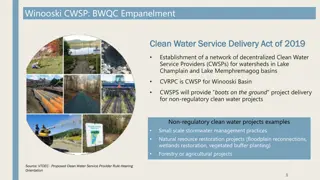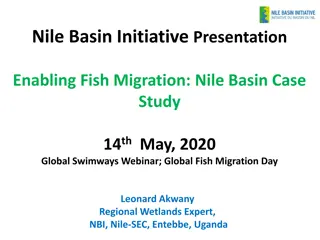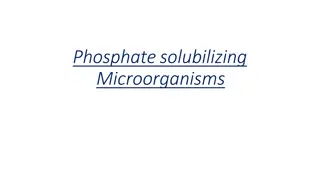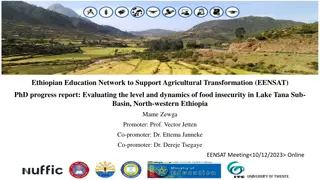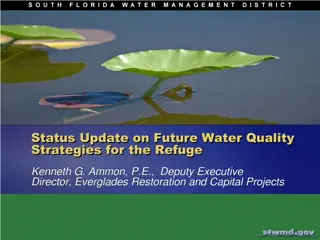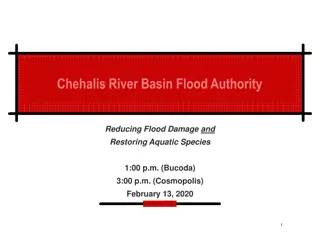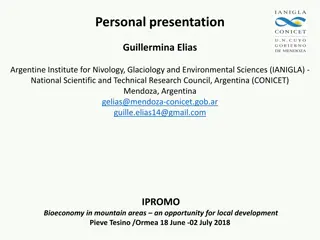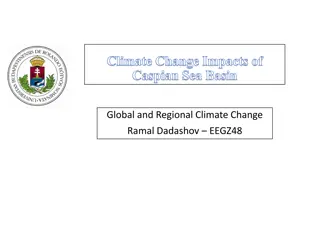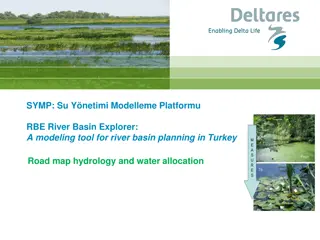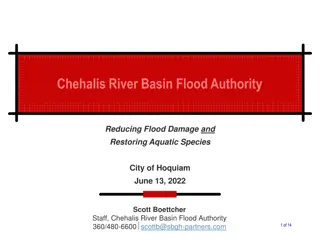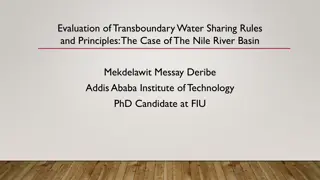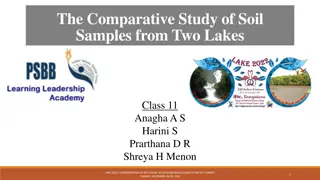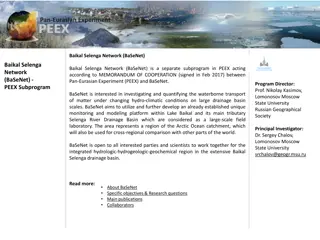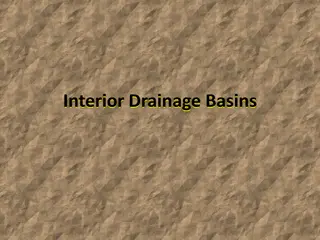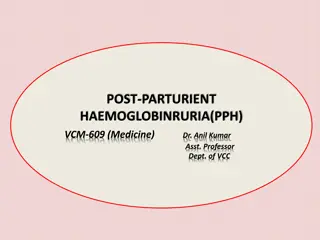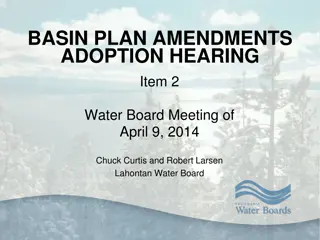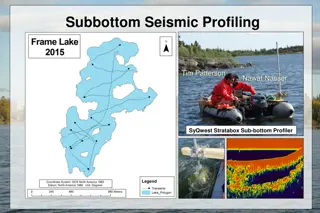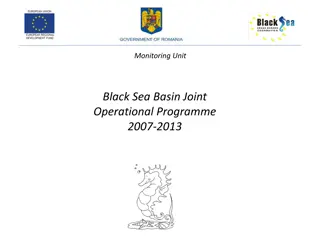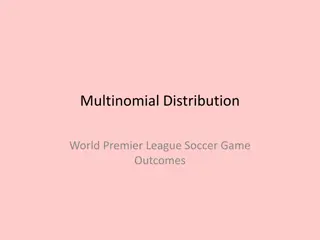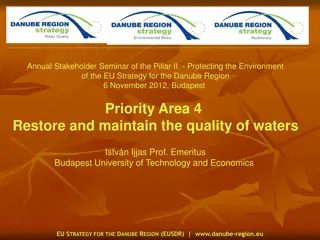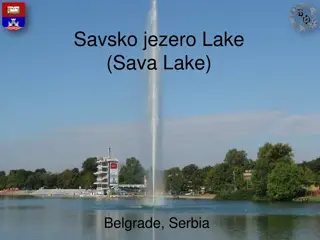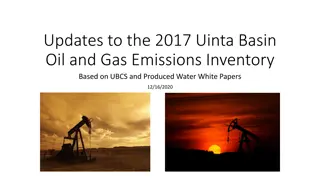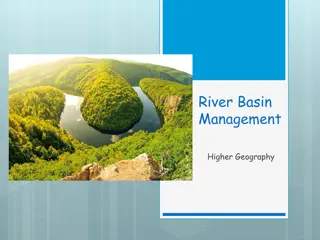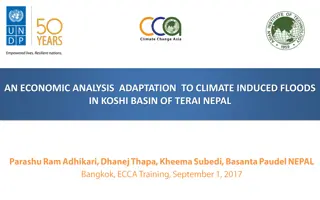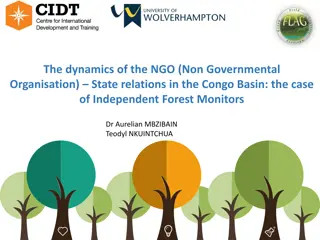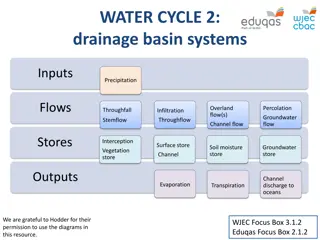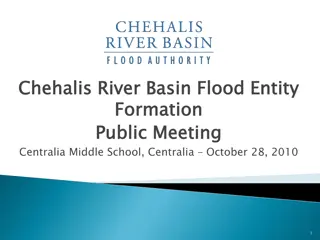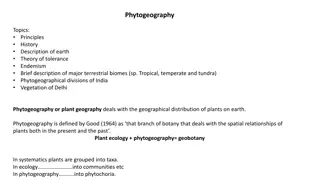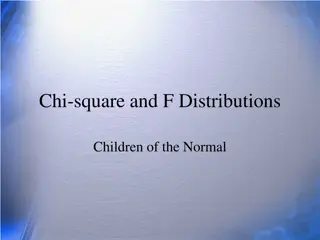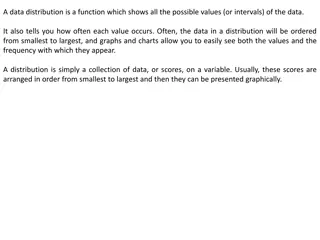Exploring Phosphorus: History, Distribution, and Impact in the Lake Champlain Basin
Explore the history and significance of phosphorus, a nutrient of concern in the Lake Champlain Basin. From its discovery by Hennig Brand in 1669 to its various uses in fertilizers, detergents, and even warfare, phosphorus plays a critical role in the environment. Discover the global phosphorus pools in different reservoirs, from atmospheric to aquatic and terrestrial sources. Understand the availability and limitation of phosphorus in the environment and its impact on eutrophication.
Download Presentation

Please find below an Image/Link to download the presentation.
The content on the website is provided AS IS for your information and personal use only. It may not be sold, licensed, or shared on other websites without obtaining consent from the author. Download presentation by click this link. If you encounter any issues during the download, it is possible that the publisher has removed the file from their server.
E N D
Presentation Transcript
Nutrient of Concern Phosphorus in the Lake Champlain Basin Courtney Giles, PhD UVM EPSCoR/RACC Q1
History Phosphorus <1200 Present Manure fertilizers used 1669 Hennig Brand discovers white elemental phosphorus 1750 s Elemental P first used in matches MW: 30.97 1800 s Phosphate rock first used as fertilizer WWI WWII Phosphorus bombs; Nerve gas 1946 First PO43- - containing detergent (Tide) 1950 s First cases of eutrophication recorded in Great Lakes (persistent algae blooms) 1977 US EPA Detergent Phosphate Ban 1990 s Present Continued urban and agricultural management of P world-wide Hennig Brand, 1669
Focus Phosphorus Phosphate-containing molecules (oxidized P) MW: 30.97 inorganic organic Hennig Brand, 1669
Phosphorus availability and limitation in the environment Phosphorus in Lake Champlain Basin Overview
Global Phosphorus Pools ATMOSPHERIC AQUATIC TERRESTRIAL Organisms Organisms Water Soil GEOLOGIC Sediment Crust Mineable
Global Phosphorus Pools Water vapor Dust particles ATMOSPHERIC AQUATIC TERRESTRIAL Organisms Organisms Water Soil GEOLOGIC Sediment Crust Mineable
Global Phosphorus Pools ATMOSPHERIC AQUATIC TERRESTRIAL Organisms Organisms Water Soil GEOLOGIC Sediment Crust Mineable (1014 Tg) (1016 Tg) (103 Tg)*
Global Phosphorus Pools ATMOSPHERIC AQUATIC TERRESTRIAL Organisms Organisms Water Soil GEOLOGIC Sediment Crust Mineable 1 g H2O (1014 Tg) (1016 Tg) (103 Tg)* 3.8 million times the weight of water in Lake Champlain (25.8 km3) !
Global Phosphorus Pools ATMOSPHERIC PHOSPHATE MINING AQUATIC TERRESTRIAL Organisms Organisms Water Soil GEOLOGIC Sediment Crust Mineable
Global Phosphorus Pools ATMOSPHERIC AQUATIC TERRESTRIAL Organisms (102 Tg) Organisms (103 Tg) Water (102 -105 Tg) Soil (105 Tg) GEOLOGIC Sediment Crust Mineable
Global Phosphorus Movement ATMOSPHERIC AQUATIC TERRESTRIAL Organisms Organisms Water Soil GEOLOGIC Sediment Crust Mineable
Global Phosphorus Cycle Phosphate Rocks P mining Fertilizer Manure Runoff Animals Soil P Water Plant P Detritus Sediments Animals
Why is P pollution a problem? Phosphate Rocks P mining Fertilizer Manure Runoff Animals Soil P Water Plant P Detritus Sediments Animals
1. Its not sustainable Phosphate Rocks P mining Fertilizer Manure Runoff Animals Soil P Water Plant P Detritus Sediments Animals Approximately 8 million tons of P is lost to surface waters each year!
1. Its not sustainable Phosphorus Production Phosphate Rocks MT P/yr P mining Fertilizer Manure Runoff 2030 Animals Soil P Water Plant P Detritus Sediments Animals Approximately 8 million tons of P is lost to surface waters each year!
2. This happens Lake 226, Schindler et al. 1978
2. This happens Dead zones originating from Mississippi River nutrient loading (NASA, Lake 226, Schindler et al. 1978
2. This happens But why? Dead zones originating from Mississippi River nutrient loading (NASA, Lake 226, Schindler et al. 1978
For organisms, phosphorus is a Macronutrient Organisms need large amounts of P to survive Limitingnutrient First to run out; Available only in small amounts
Phosphorus in Organisms Bone Calcium-phosphate minerals Genetic code DNA, RNA Cell membranes Phospholipids Sugars Glucose-6-phosphate Energy - ATP
Phosphorus in Organisms Bone Calcium-phosphate minerals Genetic code DNA, RNA Cell membranes Phospholipids Sugars Glucose-6-phosphate Saenger, Principles of Nucleic Acid Structure Energy - ATP
Phosphorus in Organisms Bone Calcium-phosphate minerals Genetic code DNA, RNA Cell membranes Phospholipids www.cuny.edu Sugars Glucose-6-phosphate Energy - ATP
Phosphorus in Organisms Bone Calcium-phosphate minerals Genetic code DNA, RNA Cell membranes Phospholipids Sugars Glucose-6-phosphate www.bmrb.wisc.edu Energy - ATP
Phosphorus in Organisms Bone Calcium-phosphate minerals Genetic code DNA, RNA Cell membranes Phospholipids Sugars Glucose-6-phosphate uic.edu Energy ATP Nutrient Storage Phytate
Phosphorus in Organisms Bone Calcium-phosphate minerals Genetic code DNA, RNA Cell membranes Phospholipids Sugars Glucose-6-phosphate Energy ATP Nutrient Storage/ Cell Signaling Phytate
Phosphorus in Organisms Living things need P available P is quickly consumed ...
Intro to Environmental P Chemistry Total PvsAvailable P Living things need P available P is quickly consumed ...
Intro to Environmental P Chemistry Total PvsAvailable P All P-containing molecules - Soluble inorganic P - Soluble organic P - Particle-bound inorganic P - Particle-bound organic P Total P In Water Sediment Soil Organisms Etc..
Intro to Environmental P Chemistry Total PvsAvailable P All P-containing molecules - Soluble inorganic P - Soluble organic P - Particle-bound inorganic P - Particle-bound organic P Total P
Intro to Environmental P Chemistry Total PvsAvailable P All P-containing molecules - Soluble inorganic P - Soluble organic P - Particle-bound inorganic P - Particle-bound organic P Total P PARTICLE sediment
Intro to Environmental P Chemistry Total PvsAvailable P All P-containing molecules - Soluble inorganic P - Soluble organic P - Particle-bound inorganic P - Particle-bound organic P PARTICLE
Intro to Environmental P Chemistry Total PvsAvailable P Orthophosphateles - Soluble inorganic P - Soluble organic P - Particle-bound inorganic P - Particle-bound organic P
Intro to Environmental P Chemistry Total PvsAvailable P Phosphate (PO43-) occurs in the presence of oxygen (oxidized form) At environmental pH (5 8), phosphate carries a negative charge Molecules that contain negatively charged phosphate interact strongly with positively charged metals, minerals, and organic matter Phosphate is sticky . Precipitates with metals Sorbs to minerals & organic matter Not bioavailable when stuck
Intro to Environmental P Chemistry Total PvsAvailable P Phosphate (PO43-) occurs in the presence of oxygen (oxidized form) At environmental pH (5 8), phosphate carries a negative charge Molecules that contain negatively charged phosphate interact strongly with positively charged metals, minerals, and organic matter Phosphate is sticky . Precipitates with metals Sorbs to minerals & organic matter Not bioavailable when stuck + + + M
Intro to Environmental P Chemistry Total PvsAvailable P Biological demand and the abiotic behavior of phosphorus in the environment leads to its limitation. + + + M
Why is aquatic P pollution a problem? Phosphate Rocks P mining Fertilizer Manure Runoff Animals Soil P Water Plant P Detritus Sediments Animals
Why is aquatic P pollution a problem? Phosphate Rocks P mining Fertilizer Excess available P leads to excessive growth and eutrophication Manure Runoff Animals Soil P Water Plant P Detritus Sediments Animals
Lake Eutrophication Fertilization of surface waters Excessive growth of primary producers Eventual nutrient limitation Death of over-growth Decomposition leads to O2 consumption Lake 226, Schindler et al. 1978
Lake Eutrophication Fertilization of surface waters Excessive growth of primary producers Eventual nutrient limitation Death of over-growth Decomposition leads to O2 consumption Environmental impacts: Low light, O2 depletion, changes in food-web structure make it difficult for many aquatic organisms to survive Lake 226, Schindler et al. 1978 Economic impacts: Cost of water treatment, fisheries, recreation, tourism
Lake Eutrophication Fertilization of surface waters Excessive growth of primary producers Eventual nutrient limitation Death of over-growth Decomposition leads to O2 consumption Environmental impacts: Low light, O2 depletion, changes in food-web structure make it difficult for many aquatic organisms to survive Algal blooms occur in the shallow bays of Lake Champlain most summers Economic impacts: Cost of water treatment, fisheries, recreation, tourism
For example Missisquoi Bay 149 mt/yr Mallets Bay 61 mt/yr Burlington Bay 2.5 mt/yr
Sources of P to Lake Champlain Point Sources Waste water treatment Urban storm water Industry Clean Earth Solutions Non-Point Sources Agriculture Forested Developed cchesebro.blogspot.com publicworks.houstontx.gov
Sources of P to Lake Champlain http://peakwater.org/wp-content/uploads/2012/04/runoff-300x216.jpg STREAM BANK EROSION AGRICULTURE Point Sources Waste water treatment Urban storm water Industry FORESTED/DEVELOPED J. Tyler, UVM Non-Point Sources Agriculture Forested Developed Stream bank erosionon B. Wemple, UVM
Sources of P to Lake Champlain http://peakwater.org/wp-content/uploads/2012/04/runoff-300x216.jpg STREAM BANK EROSION AGRICULTURE Point Sources Waste water treatment Urban storm water Industry FORESTED/DEVELOPED J. Tyler, UVM Non-Point Sources Agriculture Forested Developed Stream bank erosionon B. Wemple, UVM www.lcbp.org
Transport of Phosphorus to the Lake Non-Point SourceRunoff Point Source Effluent
Transport of Phosphorus to the Lake Non-Point SourceRunoff Point Source Effluent P Dissolved Available P ++ + Sediment Bound P
Transport of Phosphorus to the Lake Non-Point SourceRunoff Point Source Effluent P The majority of P delivered to the Lake is bound to sediment. We can measure Total Suspended Solids (TSS), Total P (TP), and Soluble Reactive P (SRP, available-P) to keep track of what s being transported in rivers and streams. + + Dissolved Available P + Sediment Bound P
Transport of Phosphorus to the Lake Non-Point SourceRunoff Point Source Effluent P The majority of P delivered to the Lake is bound to sediment. If stream flow (Q) is known: + + Q (V/T) x [TP] (M/V) = P load (M/T) Q (V/T) x [TSS] (M/V) = Sed. load (M/T) Dissolved Available P + Sediment Bound P V = volume; T = time; M = mass
Phosphorus is everywhere. Phosphorus transport occurs between and within global P pools. P pollution is a problem because: 1. It s not sustainable 2. Can damage ecosystems
Phosphorus availability and limitation in the environment There are many forms of P Available P Phosphorus is limiting because: 1. High biological demand 2. Behavior of phosphates in environment In excess, P leads to over-production and eutrophication
